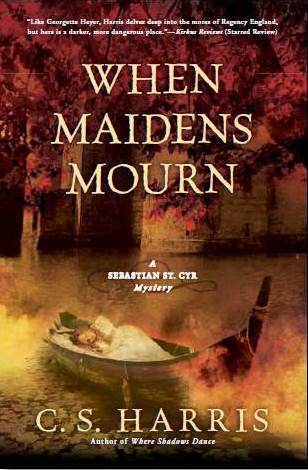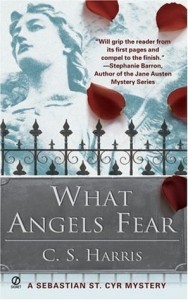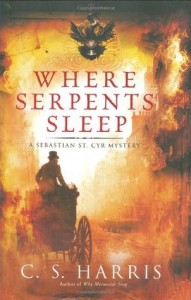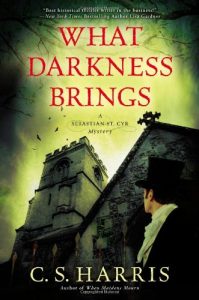 When Maidens Mourn (Sebastian St. Cyr, #7) by C.S. Harris
When Maidens Mourn (Sebastian St. Cyr, #7) by C.S. Harris Format: ebook
Source: purchased from Amazon
Formats available: hardcover, paperback, ebook, audiobook
Genres: historical fiction, historical mystery, mystery
Series: Sebastian St. Cyr, #7, #7
Pages: 341
Published by Berkley, New American Library on March 6, 2012
Purchasing Info: Author's Website, Publisher's Website, Amazon, Barnes & Noble, Kobo, Bookshop.org, Better World Books
Goodreads
Regency England, August 1812. Sebastian's plans to escape the heat of London for a honeymoon are shattered when the murdered body of Hero's good friend, Gabrielle Tennyson, is discovered drifting in a battered boat at the site of a long-vanished castle known as Camlet Moat. A beautiful young antiquarian, Miss Tennyson had recently provoked an uproar with her controversial identification of the island as the location of Camelot. Missing and presumed also dead are Gabrielle's two young cousins, nine-year-old George and three-year-old Alfred.Still struggling to define the nature of their new marriage, Sebastian and Hero find themselves occasionally working at cross-purposes as their investigation leads from London's medieval Inns of Court to its seedy back alleys, and from grand country homes to rural enclaves where ancient Celtic beliefs still hold sway. As he probes deeper, Sebastian also discovers dark secrets at the heart of the Tennyson family, and an enigmatic young French lieutenant with a dangerous, mysterious secret of his own.Racing to unmask a ruthless killer and unravel the puzzle of the missing children, Sebastian and Hero soon find both their lives and their growing love for each other at risk as their investigation leads to Hero's father, who is also Sebastian's long-time nemesis... and to a tall, dark stranger who may hold the key to Sebastian's own parentage.
My Review:
 The legend of King Arthur has always loomed large over Britain, but even more so at times when the current monarch is less than popular. Or, as in the case of the corpulent, aging, spendthrift Prinny, Prince Regent for his mentally incapacitated father George III, not just unpopular but downright detested for his endless need for more money and therefore higher taxes to maintain his profligate lifestyle AND continue to prosecute Britain’s seemingly endless war with Napoleon and France.
The legend of King Arthur has always loomed large over Britain, but even more so at times when the current monarch is less than popular. Or, as in the case of the corpulent, aging, spendthrift Prinny, Prince Regent for his mentally incapacitated father George III, not just unpopular but downright detested for his endless need for more money and therefore higher taxes to maintain his profligate lifestyle AND continue to prosecute Britain’s seemingly endless war with Napoleon and France.
At times like these, King Arthur, the “once and future king” shifts from being a mere legend to a figure of hope. People are looking for a savior from the hated Hanoverian dynasty and praying for a fated king from the mists of time and myth skirts the edges of treason without quite toppling into that abyss.
Not that Prinny isn’t scared out of his mind over the broadsheets that appear everywhere, and especially not that the powerful Lord Jarvis, propping up Prinny’s throne, isn’t looking for a way to tamp down the enthusiasm. No matter how many lies he has to tell, how many experts he has to blackmail, and how many people he has to kill in the cause of keeping Britain safe and Prinny’s throne secure.
Even if he has to lie to his daughter and have one of her dearest friends murdered. As far as Jarvis is concerned he’ll do whatever is necessary in service of what he considers, not merely the “Greater Good”, but the highest cause of all.
But the murder of Gabrielle Tennyson, his daughter Hero’s dear friend, puts Jarvis in opposition – again, pretty much perpetually – to Hero’s new husband, Sebastian St. Cyr, Viscount Devlin. As always, Devlin is determined to get to the bottom of this devilishly complicated case that has, so far, left one woman dead and put her two missing nephews in danger of following her into the grave – if they haven’t already.
While the conflict between Hero’s loyalties and Devlin’s secrets open a chasm in their barely-begun, frequently tense relationship and ink-barely-dry marriage. A chasm they may not be able to navigate across – not even for the sake of the child they married to protect.
 Escape Rating A+: The Sebastian St. Cyr series, as a collective whole, comprises three elements that are endlessly fascinating. As historical mysteries, they generally begin with a dead body, in this particular case that of Gabrielle Tennyson. Thus there is always a case to be solved, with St. Cyr, Viscount Devlin, as the principal investigator into whodunnit and often more importantly, why it was done and all too often, who ordered it done.
Escape Rating A+: The Sebastian St. Cyr series, as a collective whole, comprises three elements that are endlessly fascinating. As historical mysteries, they generally begin with a dead body, in this particular case that of Gabrielle Tennyson. Thus there is always a case to be solved, with St. Cyr, Viscount Devlin, as the principal investigator into whodunnit and often more importantly, why it was done and all too often, who ordered it done.
The who ordered it part leads directly to the second element. These stories take place during the Napoleonic Wars or in their immediate aftermath. Devlin served as a cavalry officer and suffers from PTSD as a result of that service. His penchant for investigating murders is one of the ways he copes with his condition.
But Devlin is a member of the aristocracy, the heir to an Earldom. When he pokes his nose into the doings of the ‘high and mighty’ he can’t be ignored or shoved aside – not that plenty haven’t tried. As a consequence, there is quite often a political element to his investigations, along with a deeper than usual dive into the frequently rancid sausage-making of government – with insights into history as they are happening.
When Maidens Mourn dives into that morass from a surprising direction, as the murder of Gabrielle Tennyson leads back to the government’s underhanded contrivance to put the legend of King Arthur to rest. Again. (“This has all happened before and it will all happen again.”)
Diving into the Arthurian legends in this particular instance proved to be doubly poignant, as it touches, indirectly and fictionally, on the very real Arthur, Lord Tennyson, who will grow up to write The Idylls of the King, a Victorian reimagining of, you guessed it, the legends of King Arthur.
Along with the investigation and the politics and history, there’s a third, personal element to each story, an element that at first seemed the most prominent in this case. Devlin and Hero have been married a scant four days when this story opens. Their marriage is one of necessity, as Devlin needs an heir, and Hero is carrying that heir after the events in Where Serpents Sleep, when they spent one night grasping for life while expecting to die.
Hero is the daughter of Devlin’s greatest enemy, and she is now trapped between two conflicting sets of secrets, a conflict that may cost her any possibility of happiness in her hasty but necessary marriage. Devlin has secrets of his own that he does not want to reveal to a woman he is not sure he can trust – and yet there can be no trust if one of them doesn’t give up something.
Part of what makes this series so interesting is that Hero is likely to prove the one with the stronger will and the better reason not to compromise, but as things stand at the end of this book, how they will go on together is yet uncertain.
 At least, it’s uncertain at this particular point in the series. I began reading St. Cyr almost 20 years ago, at the beginning with What Angels Fear. At first, it read as a combination of historical mystery firmly grounded in its historical period with a touch of romance. What initially captivated me was that combination of history and mystery, and the way that the historical period has come to the fore – as well as the continuing development of this fascinating cast of characters – has made this one of my favorite comfort reads.
At least, it’s uncertain at this particular point in the series. I began reading St. Cyr almost 20 years ago, at the beginning with What Angels Fear. At first, it read as a combination of historical mystery firmly grounded in its historical period with a touch of romance. What initially captivated me was that combination of history and mystery, and the way that the historical period has come to the fore – as well as the continuing development of this fascinating cast of characters – has made this one of my favorite comfort reads.
So I’ve read the early books and the later books and am hit or miss in the middle. I’m systematically changing those misses to hits as I wait for each new book in the series. Which means that next up will be What Darkness Brings, the next time I need a reading pick-me-up to whisk me away!
